One of the advantages of the relatively thin grafts produced by follicular unit extraction (FUE) as compared to their strip harvest counterparts is that they can be more easily placed into recipient sites that are created in a more dense pattern. Here, Dr. Carlos Wesley describes this in a patient who desired a hairline advancement using FUE.
Densely Packing and FUE
Collapse
X
-
 Densely Packing and FUE
Densely Packing and FUE
-
I have a friend in his 50s who has a high hairline and no MPB. Lowering a hairline in this type of individual is acceptable. For a young man, a low hairline can be a temptation. If there is a family history of Norwood 5 or 6, dense packing is a really bad idea. Many studies indicate, dense packing can reduce yield to 70% and even lower. When follicle regeneration becomes more reliable, up into the 90-100% range, this won't be such a big issue. As things are in 2013, a man has a limited number of donor grafts. If he uses them all in a dense packed frontal area and later loses hair, he'll become a difficult repair case. Redistribution of previously transplanted hair may become necessary as well as tapping into alternative hair sources.
But yes, an older guy without signs of MPB and a strong family history of full heads of hair, have at it if you want to lower your hairline. A few men do have donor to burn.
35YrsAfter also posts as CITNews and works at Dr. Cole's office
forhair.com
Cole Hair Transplant
1045 Powers Place
Alpharetta, Georgia 30009
Phone 678-566-1011
email 35YrsAfter at chuck@forhair.com
Please feel free to call or email me with any questions. Ask for Chuck -
Great reply, 35YrsAfter. Your points are very well taken. This approach would not be appropriate for young patients with anticipated-to-be-significant MPB based on family history and exam. For those patients, there is certainly a limit to their donor supply.
While not an exact prognostication, our practice's survey estimating the number of lifetime supply of follicular units at least helps shed some light on that issue. It was published in this May's Dermatologic Surgery journal and can be viewed here.Carlos Wesley, MD
Member, International Alliance of Hair Restoration Surgeons
View my IAHRS Profile
1050 Fifth Avenue
New York, NY 10028
844-745-6362
http://www.drcarloswesley.com
info@drcarloswesley.com
Comment
-
With all due respect, I don't really see this being an advantage of FUE given that FUT strips undergo dissection under microscope so if anything I would have thought it would the opposite; that with FUT you could more reliably dense pack with better density as you can carefully dissect the one unit grafts as thin as required. Nevertheless, it is reassuring to see what FUE can achieve regarding density and yield. Very impressive.Comment
-
I have no idea why FUE grafts are any better than FUT grafts. They arent. In fact, when doing FUE ,you are going in blind so to speak. Hoping it grabs the entire follicle when extracting.
I think FUE has advantages, but not dense packing. That has everything to do with the donor hair available and the skill of the surgeon .Comment
-
Thanks, Follicle Death Row & drybone, for your replies. It certainly makes for an interesting topic of discussion.
While every clinic differs slightly in their approach and what works best in their hands, a point of clarification that I think is important not to gloss over is the essential shape of the grafts prior to transplantation. There should, therefore, be a limit to the degree of graft trimming.
The "Hair Transplantation" textbook has, for many years, stated that:
"The 'perfect' follicular unit graft with very little dermis, sufficient subcutaneous fat, intact sebaceous gland, and an overall pear shape."
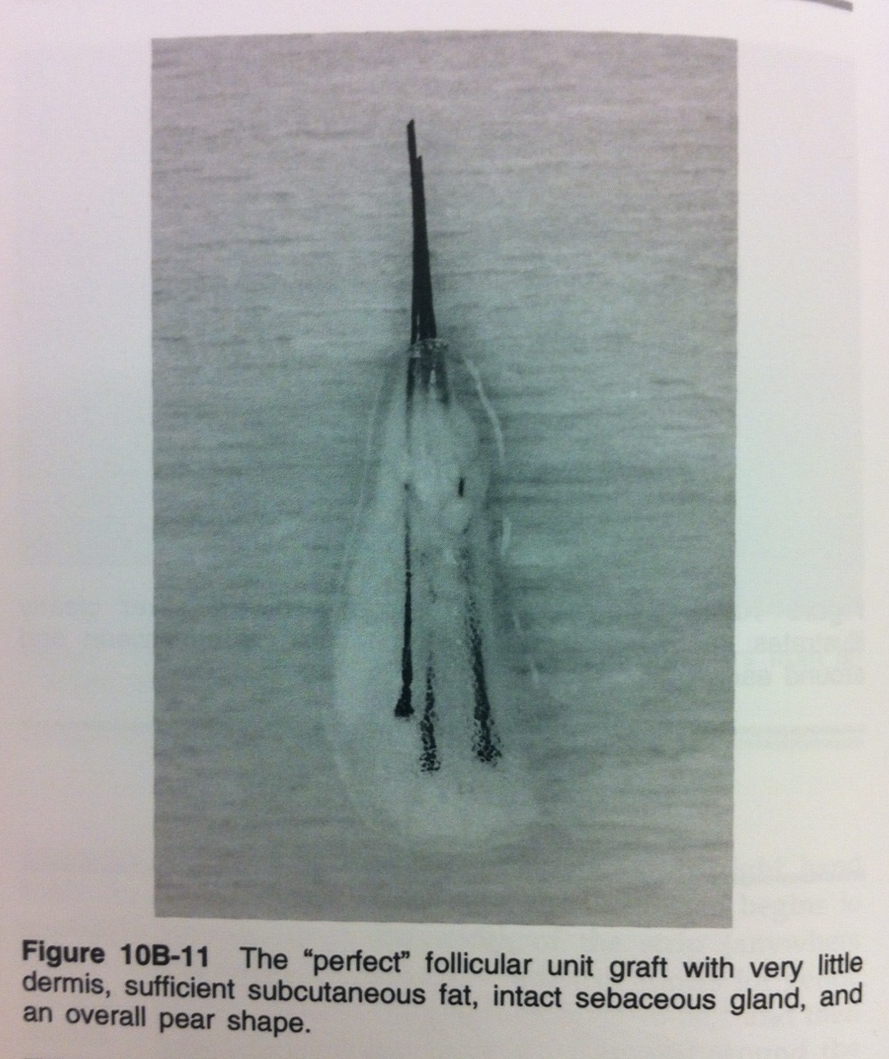
Leaving ample protective tissue around the infundibulum and dermal papilla (stem cell-containing portion of the hair follicles) shields the grafts from various environmental hazards while they are out of the body (e.g. desiccation and the trauma of being handled when transplanted). The amount of tissue has been shown to directly impact the survival of grafts in numerous studies (Dr. Michael Beeher's "surrounding tissue" study, Dr. Seager's viability study, and Dr. Greco's "crush study").
Looking at Beehner's study (below) we see how the amount of protective tissue does influence graft survival (especially at 19 months postoperatively).
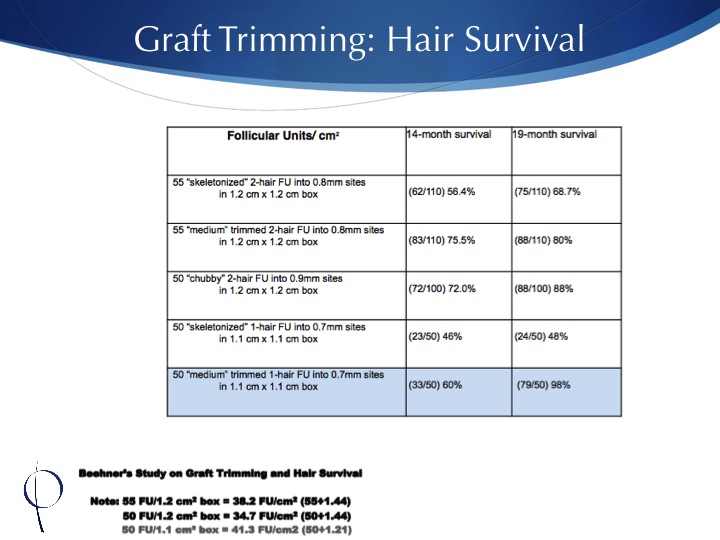
To better understand this investigation, let's focus on the grafts of the same type. So, two-haired grafts, for example, differ mainly in the amount of tissue surrounding them: from "skeletonized" (significantly trimmed) to "chubby" (not markedly trimmed). That's a 129% difference in graft survival at 19 months (see below).
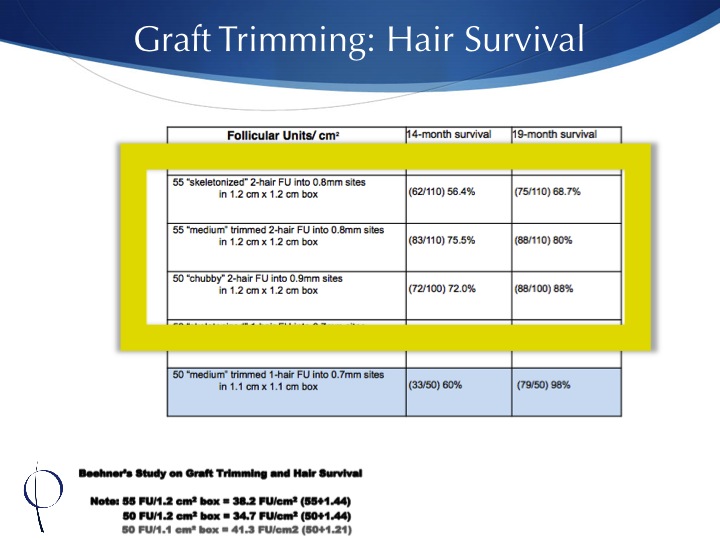
Now, when we focus on one-haired follicles (which are more commonly used in the hairline of patients), the difference in transplanted hair survival is even more pronounced (see below). Dr. Beehner showed a 204% difference in hair survival when the grafts were trimmed to a skeletonized shape versus their "chubby" counterparts.
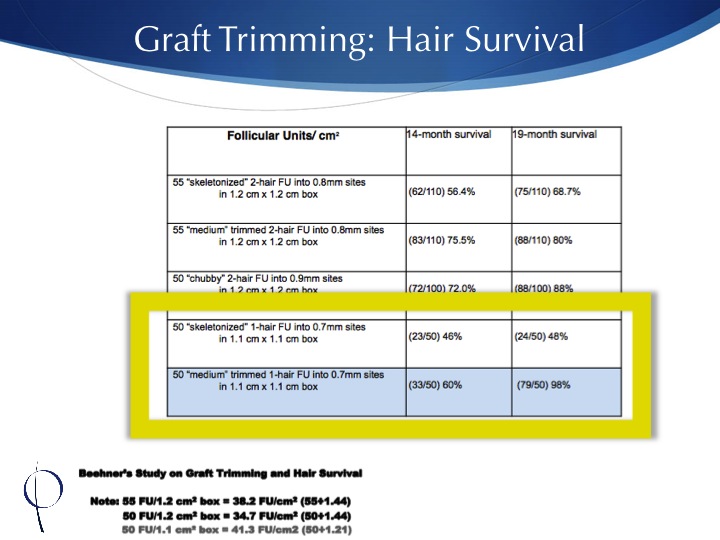
Why does this matter? And how does this relate to my initial posting? Well, the beauty of strip harvest (FUT or FUSS) grafts is the amount of surrounding tissue that can be included in each graft to ensure the greatest survival of transplanted follicles (see below). Trimming that to an advanced degree in order to pack them into sites that may not be able to accommodate grafts with more protective tissue may have the aforementioned detrimental effect on their ultimate survival. Now, while the general lack of protective tissue of FUE grafts is not necessarily advantageous, it may allow the grafts to more easily fit into more closely packed recipient sites.
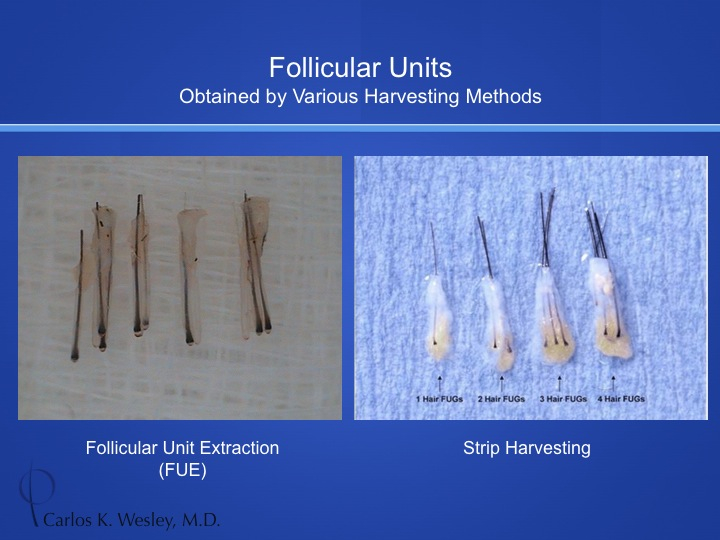
Fortunately, the IAHRS site represents a number of excellent surgical clinics with skilled physicians and technicians. So, these reproduced findings may not hold true in all patients with whom these clinics have dealt. I do feel, however, that these findings are important to point out.
- Beehner M. A comparison of hair growth between follicular-unit grafts trimmed “skinny” vs. “chubby.” Hair Transplant Forum Int 1999;9:16.
- Seager DJ. Micrograft size and subsequent survival. Dermatol Surg 1997; 23:757-61.
- Greco JF, Kramer RD, Reynolds GD. A crush study review of micrograft survival. Dermatol Surg 1997;23:752-5.
Carlos Wesley, MD
Member, International Alliance of Hair Restoration Surgeons
View my IAHRS Profile
1050 Fifth Avenue
New York, NY 10028
844-745-6362
http://www.drcarloswesley.com
info@drcarloswesley.com
Comment
.pdf)
Comment